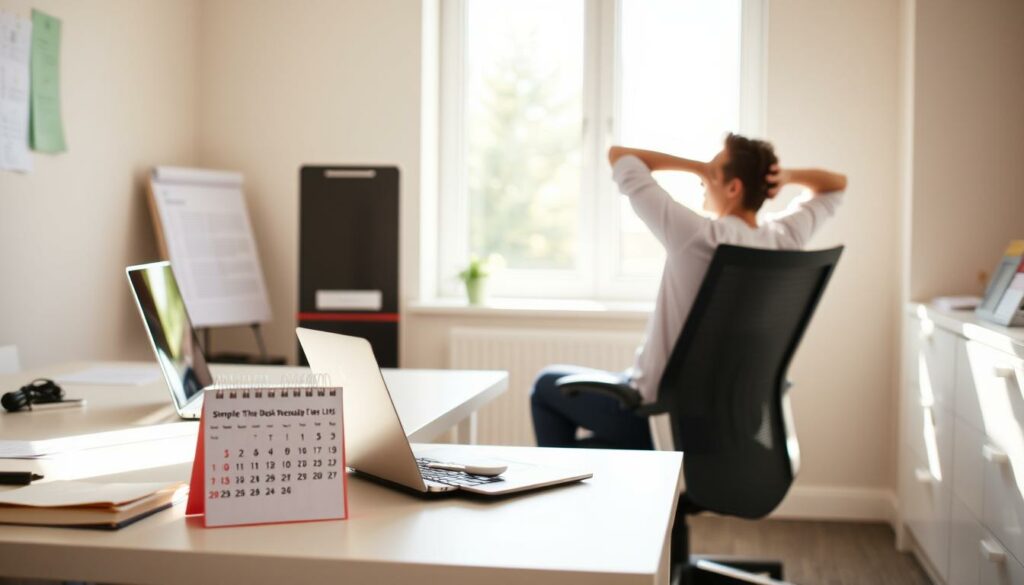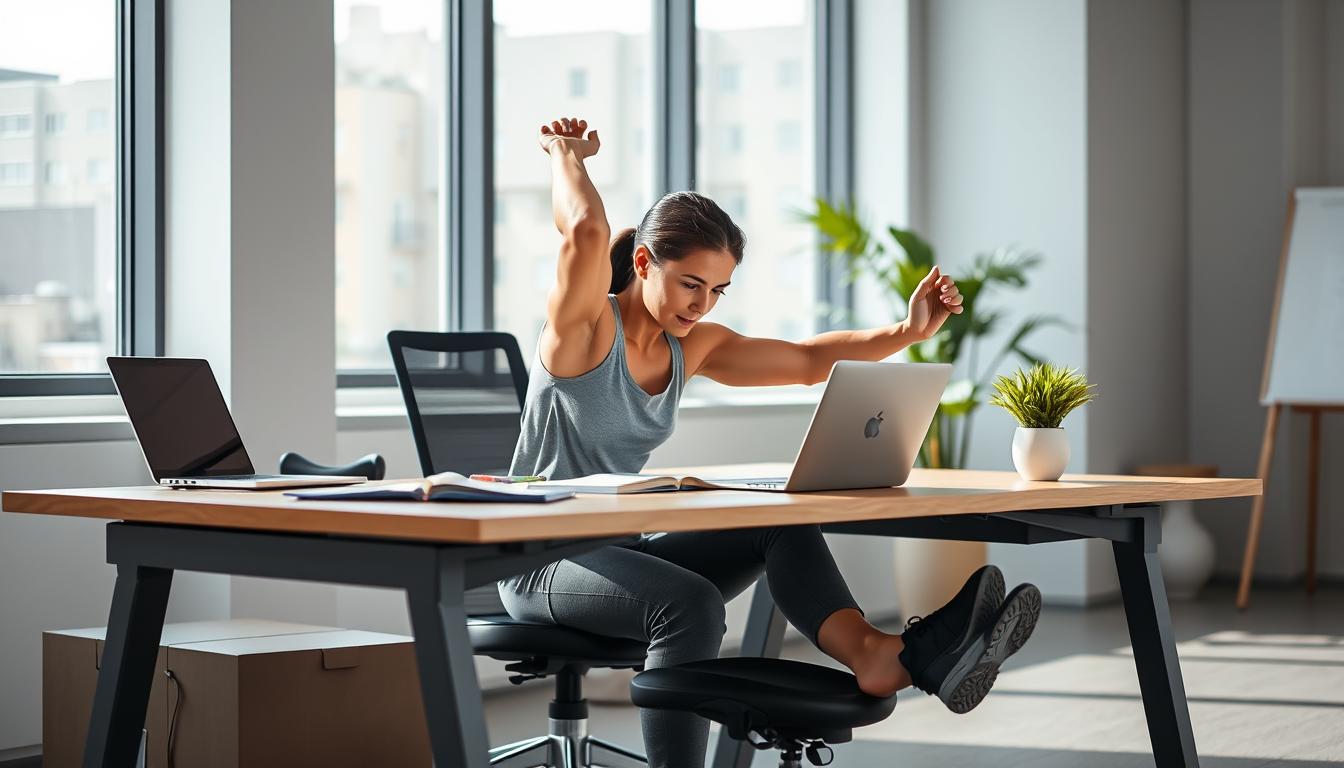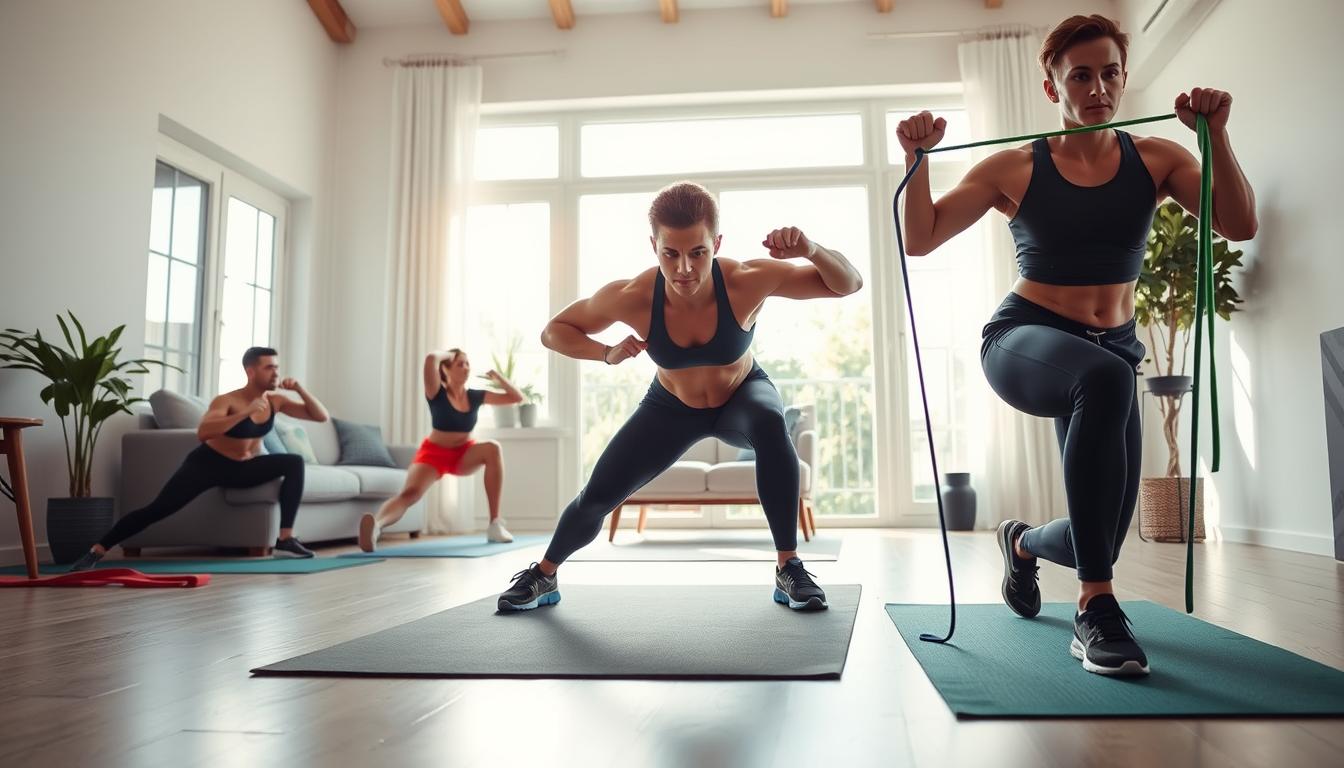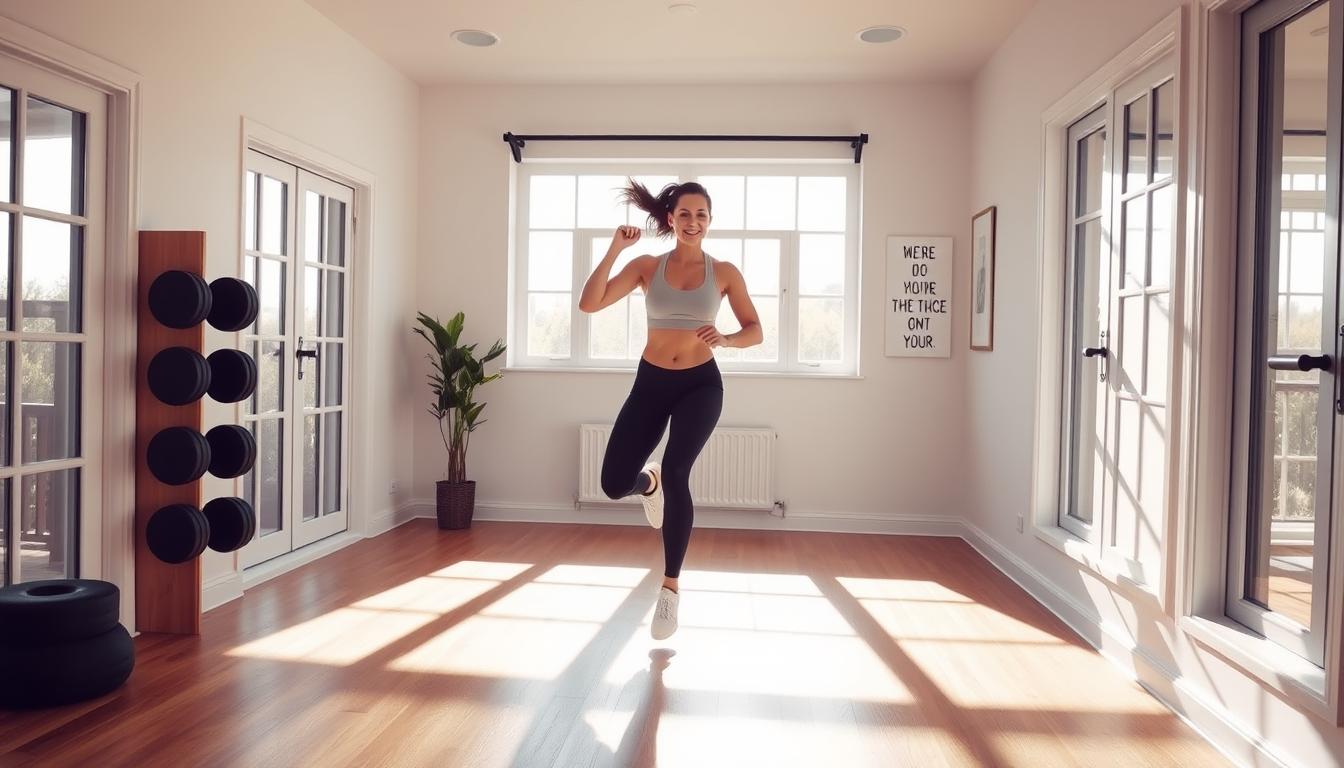Do you often feel tired and unproductive at work? Can a short burst of exercise really make a difference in your health and work performance?
You likely spend most of your day sitting at a desk. Regular exercise can boost your energy and help you focus better. Adding short workouts to your office routine can change everything.
By adding simple office exercises to your daily routine, you can stay active. This reduces the risk of chronic diseases and boosts your overall well-being.
Key Takeaways
- Boost energy and productivity with short office workouts
- Improve overall health and reduce chronic disease risk
- Enhance focus and concentration with regular exercise
- Simple desk workouts can be done in just a few minutes
- Incorporating physical activity into your office routine is easy
The Hidden Dangers of Prolonged Sitting
Sitting at a desk all day can harm your health and wellbeing. In today’s offices, many employees sit for most of their workday. Prolonged sitting is linked to many health risks that affect both body and mind.

Physical Health Risks
Sitting too much at work raises the risk of heart disease, type 2 diabetes, and some cancers. Regular exercise can help, but it’s hard to move enough when you’re sitting all day.
Mental Health Impact
The effects of sitting too much on mental health are significant. It can lead to more depression and anxiety. Using office fitness tips daily can help. It promotes activity and cuts down on sitting.
Why 10-Minute Workouts Are Effective for Office Workers
Even short exercise sessions, like 10 minutes, can greatly benefit office workers. Adding quick office workouts to your day can keep you active at work and boost your health.
These workouts fit easily into a busy schedule. By doing desk exercises, you can improve your health and focus.
The Science Behind Short Exercise Bursts
Studies show that short exercise bursts are good for your heart and energy. These quick sessions help fight the bad effects of sitting too long.
Short physical activities also make you feel better and less stressed. They increase certain brain chemicals that lift your mood.
Benefits for Productivity and Focus
Doing quick office workouts can make you more focused and productive. Exercise sharpens your mind, helping with memory and solving problems.
Adding desk exercises to your day can make you work better and more efficiently.
| Benefits | Physical Activity | No Physical Activity |
|---|---|---|
| Energy Levels | Increased | Decreased |
| Productivity | Improved | Reduced |
| Mood | Enhanced | Negative Impact |

Preparing Your Workspace for Movement
Getting your office ready for exercise is key to adding office exercises to your day. A few easy changes can make your space better for fitness and health.
Creating Space for Exercise
To do desk workouts well, you need room around your desk. Remove any clutter or things that get in the way. Make sure you can stretch, move your legs, and do exercises without hitting things or people.
No-Equipment vs. Simple Equipment Options
Choosing between office fitness tips that use equipment or bodyweight exercises is important. Many desk workouts don’t need any equipment, using your body as resistance. But, if you like using simple tools, try resistance bands or a small exercise ball.
| Equipment Type | Benefits | Examples |
|---|---|---|
| No Equipment | Convenient, cost-effective | Chair squats, desk push-ups |
| Simple Equipment | Variety, increased resistance | Resistance bands, exercise balls |
By setting up your workspace right, you can easily add physical activity to your workday. This boosts your productivity and health.
The Best 10-Minute Office Workouts for People Who Sit All Day
For those who sit a lot, 10-minute office workouts can change everything. Short, effective exercises can boost your health and mood.
Workout Structure and Frequency Guidelines
To make the most of your 10-minute workouts, structure them well. Mix cardio, strength, and flexibility exercises. Try to do 2-3 short workouts a day, especially after sitting for a long time.
- Start with a 2-minute warm-up of light cardio, such as jumping jacks or jogging in place.
- Follow with 6 minutes of strength or resistance training using body weight or light office-friendly equipment.
- Finish with 2 minutes of stretching to cool down and improve flexibility.
Adapting Exercises for Different Fitness Levels
It’s important to adjust workouts to fit your fitness level. Beginners should start with easier exercises and gradually get harder. More advanced people can try harder movements or add resistance.
Modification Tips:
- Adjust the intensity by changing the pace or adding more repetitions.
- Use office supplies like water bottles or chairs for added resistance.
How to Incorporate These Workouts Into Your Schedule
Adding these workouts to your busy schedule is easier than you think. Try to do them during your lunch break or break them up into shorter sessions throughout the day.
Tip: Use a reminder on your phone or a note on your desk to remind you to take breaks and move.
Complete Desk-Based Stretching Routine
Desk stretches are a simple way to fight the bad effects of sitting too long. They help improve your posture, reduce muscle tightness, and boost your health.
Upper Body Desk Stretches (Step-by-Step)
Begin with upper body stretches. Start with shoulder rolls: roll your shoulders forward and backward. Do this 10-15 times. Then, do a chest stretch by leaning back on your desk. Hold for 15-30 seconds.
Try the arm across the chest stretch: hold one arm straight and pull it across your chest with the other. Hold for 15-30 seconds, then switch arms.
Lower Body Stretches While Seated (Step-by-Step)
For lower body stretches, start with ankle rotations. Lift your feet and rotate your ankles. Next, do a seated leg stretch by straightening one leg and leaning forward. Hold for 15-30 seconds, then switch legs.
Neck and Shoulder Tension Relief Sequence
Relieve neck and shoulder tension with simple stretches. Start by tilting your head to the side, bringing your ear to your shoulder. Hold for 15-30 seconds, then switch sides. Next, do a shoulder blade squeeze: sit up straight and squeeze your blades together. Hold for 5-10 seconds, then release. Repeat 10-15 times.
Adding these desk stretches to your day can significantly reduce muscle tension and make you more comfortable at work. Make stretching a daily habit to stay active and healthy.
Standing Strength Workout for Your Office Space
You can boost your office fitness with a simple standing strength workout. This guide will show you exercises to do at your desk. They improve your health and work performance.
Lower Body Strengthening Exercises
Let’s start with lower body exercises you can do standing. These are easy, don’t need much space, and are discreet.
- Squats: Stand with feet apart, then lower like sitting. Push back up. Do 10-15 repetitions.
- Calf Raises: Stand on a step with heels off. Raise up, then lower. This targets your calf muscles. Do 15-20 repetitions.
Core Activation Movements
Core strength is key for stability and posture. Here are some standing exercises for your core.
- Standing Leg Raises: Stand with feet together, lift one leg straight. Hold, then lower. Do 10-15 repetitions on each leg.
- Standing Bicycle Crunches: Stand with feet apart, hands behind head. Bring one elbow to the opposite knee. This mimics a cycling motion. Do 10-15 repetitions on each side.
Upper Body Toning Without Equipment
You can tone your upper body without equipment. Here are some exercises.
- Push-ups Against the Desk: Stand away from your desk, hands on the edge. Lower, then push back up. This targets your chest and triceps. Do 10-15 repetitions.
- Arm Circles: Stand with feet apart, arms extended. Make small circles with your hands for 10-15 repetitions.
| Exercise | Repetitions | Target Muscle |
|---|---|---|
| Squats | 10-15 | Legs |
| Calf Raises | 15-20 | Calves |
| Standing Leg Raises | 10-15 per leg | Core |
| Push-ups Against the Desk | 10-15 | Chest & Triceps |
Adding these standing exercises to your daily routine boosts fitness and productivity. They follow effective office fitness tips and quick office workouts.
Chair-Based Circuit Workout
Turn your office chair into a fitness tool with this chair-based circuit workout. It’s perfect for office workers. You can add it to your daily routine to boost your health and work performance.
Seated Cardio Movements (Step-by-Step)
Begin with seated cardio exercises to raise your heart rate. Start with seated marching: lift your legs off the floor and march in place. Do this for 30 seconds, rest for 15 seconds, and repeat.
Next, do seated leg lifts: lift one leg, hold for a second, and lower it without touching the floor. Then lift the other leg. Alternate for 30 seconds.
Chair-Assisted Strength Exercises (Step-by-Step)
Now, do chair-assisted strength exercises to build muscle. Start with chair dips: place your hands on the chair’s edge, lower your body, and straighten your arms to return. Do 10-15 repetitions.
Another good exercise is seated leg press: sit on the chair’s edge and place your feet flat. Lift your legs straight out, then lower them back down. Repeat for 15 repetitions.
Balance and Stability Work Using Your Chair
Finally, add balance and stability exercises to strengthen your core. Try seated single-leg lifts: lift one leg off the floor and balance on the other. Hold for 10 seconds, then switch legs and repeat.
For more challenge, do seated torso twists: sit on the edge of your chair, lift your feet, and twist your torso to one side, then the other. Keep your arms extended for balance.
Office-Friendly Cardio Burst Routine
You can do cardio in a small office with the right office fitness tips. Adding cardio to your day boosts energy and health. These exercises are fast, effective, and don’t need much space or attention.
Low-Impact Cardio Options for Limited Space
There are many quick office workouts you can do at your desk or in a small area. Some examples are:
- Marching in place
- Jumping jacks (modified to reduce noise and impact)
- High knees
- Desk push-offs
These exercises raise your heart rate without needing equipment or a lot of space. They’re great for desk workouts.
Discreet Movements for Shared Office Environments
In a shared office, being mindful of your surroundings is key. You can still get a good cardio workout with movements that don’t disturb others. Some office fitness tips for discreet cardio include:
- Seated leg lifts
- Ankle rotations
- Wall toe taps
- Chair squats
These movements are subtle yet effective. They let you stay active without drawing attention to yourself.
Mindful Movement and Stress Relief Practices
Managing stress at work can be tough. But, mindfulness can help a lot. It’s about being fully present and aware of your thoughts and feelings. By adding mindful practices to your day, you can feel less stressed and happier.
Breathing Techniques to Reduce Workplace Stress
Conscious breathing is a simple yet effective way to lower stress at work. Diaphragmatic breathing calms your nervous system. Sit straight, put one hand on your belly and the other on your chest, and breathe deeply.
Try this quick exercise: inhale for four counts, hold for four counts, and exhale for four counts. Do this a few times to calm your mind and body.
Desk Meditation and Mindfulness Exercises
Desk meditation and mindfulness exercises are easy to add to your day. Start by noticing your surroundings. Feel your feet on the ground, listen to sounds, and feel the air on your skin.
Try a body scan meditation. Focus on each part of your body, starting from your toes and moving up to your head. Release any tension as you focus on each area.
Overcoming Common Barriers to Office Exercise
Many find it hard to exercise at work because of various obstacles. It’s important to know these challenges to find ways to stay active at work.
Dealing with Time Constraints and Busy Schedules
Handling a packed schedule is a big hurdle. Start by adding short exercise breaks to your day. A 5-minute stretch can make a big difference. You can also:
- Take the stairs instead of the elevator
- Use a standing desk or adjust your workstation to promote movement
- Schedule exercise into your calendar like any other important task
By focusing on your health and making small changes, you can fit exercise into your tight schedule.
Managing Self-Consciousness and Office Politics
Feeling shy about exercising at work is a big barrier. To tackle this, try discreet exercises that don’t draw attention, such as:
| Exercise | Benefit |
|---|---|
| Seated leg lifts | Improves circulation and strengthens legs |
| Desk push-ups | Strengthens upper body and improves posture |
| Chair squats | Works the lower body and improves balance |
Choosing low-key exercises helps you avoid distractions and keep a professional vibe while enjoying the benefits of office exercises.
Conclusion
You now have the tools to add the best 10-minute office workouts to your day. These tips will help you stay healthy, work better, and avoid sitting problems.
Being active at work is good for your body and mind. Short exercises can lower stress, improve focus, and make your job better.
Start with simple things like walking at lunch or desk stretches. As you get used to it, add more exercises. Every little bit helps and can greatly improve your life.
Start being healthier today. Pick exercises you like and add them to your routine. With regular effort, you’ll find a better balance between work and life.


